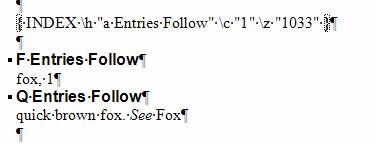INDEX
Syntax:
INDEX [ switches ]
Description: Builds an index using the index entries specified by XE fields (§2.16.5.79), and inserts that index at this place in the document. Each index entry and subentry is a separate paragraph unless the \r switch is used, in which case, an index entry and all its subentries together make up a paragraph.
Field Value: The index.
Switches: Zero or more of the following field-specific-switches.
|
Builds an index for the portion of the document marked by the bookmark indicated by text in this switch's field-argument. |
|---|---|
|
Builds an index having the number of columns per page specified by text in this switch's field-argument. That number can be 1–4. Without this switch, the number of columns is 1. |
|
The text in this switch's field-argument specifies a sequence of characters that is used to separate sequence numbers and page numbers when the |
|
The text in this switch's field-argument specifies a sequence of characters that is used to separate an index entry and its first page number. By default, a comma (,) and space sequence is used. If text contains a horizontal tab character, the page number list is right justified in the column. |
|
Builds an index using only those entries having the entry type (§2.16.5.79) specified by text in this switch's field-argument. Without this switch, all entries included. |
|
The text in this switch's field-argument specifies a sequence of characters that is used to separate the start and end of a page range. By default, an en dash is used. |
|
Builds an index such that the text in this switch's field-argument occurs as a heading—formatted with the Index Heading style—at the start of each set of entries for any given letter. If the first letter in text is example:
|
|
The text in this switch's field-argument specifies a sequence of characters that is used to separate an index entry and its cross reference (as produced by an XE entry (§2.16.5.79) having a
\t switch). By default, a period (.) and space sequence is used. example: :
|
|
The text in this switch's field-argument specifies a sequence of characters that is used to separate two page numbers in a page number list. By default, a comma (,) and space sequence is used. |
|
Builds an index using only those entries whose first letter is in the range of letters specified by text in this switch's field-argument. The letter range has the form startLetter |
|
Runs subentries into the same line as the main entry. Colons (:) separate main entries from subentries; semicolons (;) separate subentries. |
|
The text in this switch's field-argument is used as a sequence name, and the sequence number is included along with the page number, these numbers being separated by a hyphen (-), by default. Use the |
|
Enables the use of yomi text for index entries. |
|
The text in this switch's field-argument is specifies the language ID used to generate the index as defined in the ST_LangCode (§2.18.52) simple type. |
B
behavior
implementation-defined ……………………………………. 2
documenting …………………………………….….…….. 3
I
item
package-relationship ………... See package-relationship item
O
Office Open XML ……………………………………… 2, 3, 4
X
XML …………………………………………………….… 1 to 4

